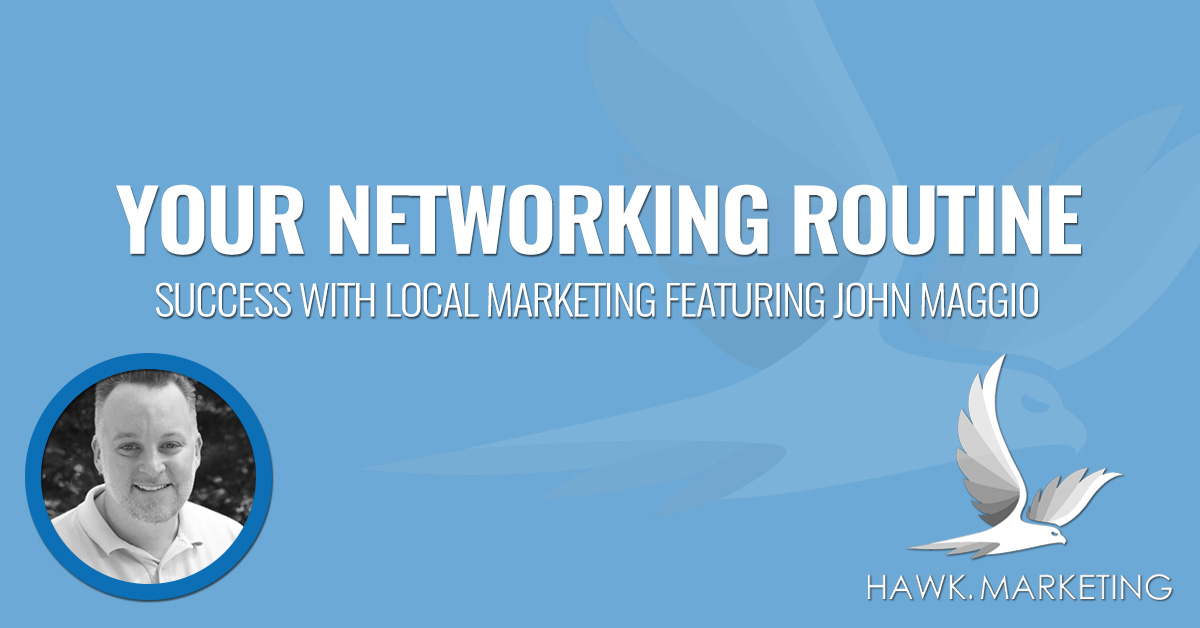
Attitude is Everything
If you think that building your network can’t bring results, then read on and learn how to leverage your network to find prospects and clients. When it comes to attitude, you are in control. Remember…
- Positive Thoughts Create Positive Feelings
- And Positive Feelings Create Positive Actions
- Then Positive Actions Create Positive Results
Are you facing a huge challenge? A milestone you are unsure of? How do you eat an elephant? One bite at a time! To keep a positive mindset, track your daily behaviors. Meaning, track your at-bats, not your home runs. Million-dollar professional baseball players miss the ball 70 percent of the time. Glass half full or glass half empty? It’s up to you.
The most important thing is that you create a realistic schedule and stick to it.
Accomplishing activities such as going to network at events and having one-on-ones gives you a sense of accomplishment. You’ll get a winning mindset, which creates positive momentum.
Judge yourself on whether you accomplish the daily activities. Be practical. Not every effort will yield success. Remember, what Pat Voelkel reminded us of, “Every prospect pays you!”
Keep it simple, and take the easy wins. Planning is great, but don’t be caught in the trap! The trap of continuously planning and over planning and never taking action! “Paralysis by analysis” will set in.
Your Routine
You can only control your behavior. You may not be able to control the direction of individual sales or opportunities, but you can harness the power of averages to find success. To do this, you need to measure your actions and activities. If you can find a realistic daily regimen to engage in, you can not only be successful but feel successful the entire time.
Here Are a Few Things to Think About When Planning Your Schedule
Would it be easier to plan for one day or one month? Clearly, it is easier to take it one day at a time. Would it be easier to accomplish the three most important items for the day or the twenty things on your to-do list?
Many professionals plan in one-week increments and limit their focus to one, two, or three tasks for their entire day! That’s all? Yes, and if they accomplish those tasks, they certainly will keep working, but the point is, they didn’t overload themselves with a huge list of tasks that are nearly impossible to accomplish. Also, they don’t spend all their day concocting complex plans.
Focus on Your Efforts When You Network
Remove emotion from sales success or failure. Do not be emotionally attached to the outcome. Remember, the prospect is the one that chooses you. Not the other way around.
If you are doing your planned activities for the day, you are winning. Going to network at all the scheduled events you had planned for that week, means you are winning. If you attach yourself too closely to sales numbers, you can find yourself feeling down. Your prospects and network partners will see your grief. Don’t let yourself slip into this cycle.
One of the best ways to avoid fatigue and generate success is to look for quality over quantity. Most of your efforts should be about qualifying your prospects. Chasing unqualified, low-quality prospects can leave you feeling frustrated. Endless follow-ups, shallow promises, and tons of time wasted.
When qualifying your prospect, try to identify the core challenges they face. If a prospect is not facing the challenges you have identified as your core services, move on (ask for a referral of course). Unqualified prospects are a huge waste of time, money, and effort.
That is why it is worth mentioning again. Do not chase, convince, or force. The prospect chooses. Present, follow up once, and move on.
Start from the End
To get started, try reverse-engineering your goal to find your daily regimen. What’s your goal? Maybe you want to bring home $100,000 in gross income? In general, pick an easy number divisible by ten. How many sales do you need to make this number a reality? What number of presentations do you have to do to make those sales happen? How many phone calls or networking events must you go to book those meetings?
Take a moment to fill out the following;
What is your Income or Revenue Goal for the Year? _______________
How many new clients do you need to achieve this number? _______________
Find your average. It is your total monthly sales divided by the number of new clients. It does not “depend”! There is always an average. If there is not enough data for a month, use a quarter year or a years’ worth of data. For example; total annual sales divided by the total number of clients/contracts.
To achieve the number of new clients you need, how many presentation meetings do you need to have? In other words, how many times must you present to a qualified lead to convert a new client? _______________
Understanding How to Convert Efforts into Results Through Your Network
To achieve your presentation goal, how many initial one-on-one coffee meetings, introductions or conversations must you have? _______________
Divide that number by 52 weeks. How many conversations must you start each week? _______________
Is this number realistic? Y or N
Common prospecting activities include; telephone cold calling, cold walk-in, referral meetings, networking events, and follow up calls. Remember, you must conduct these activities with genuine intent. In other words, work with a bias towards results. You cannot leave ten voicemails with zero follow up and expect results. On the other hand, you cannot simply attend networking events and not engage.
So, how many of each of these activities do you need to perform to start the needed amount of conversations?
Cold Calls: ________________ = ______________ meetings?
Cold Walk-ins: _____________ = ______________ meetings?
Referral Requests: ___________ = ______________ meetings?
Networking Events: __________ = ______________ meetings?
Follow Up Calls_____________ = ______________ meetings?
Which activities are your most productive?
More Money… More Problems
When creating our company, Hawk Marketing, we performed a similar exercise. We looked at what it would take to achieve a million annual sales. How many clients it would take? What numbers would have to be delivered? How many people would have to be hired to create and implement assets? It started to look overwhelming and expensive, almost immediately. At the end of the exercise, the amount of physical work and mental stress it would take to achieve this amount was huge.
We discovered that there would be quite a few moving parts to reach that goal. First, we struck out to see how many sales we would need to complete to achieve this revenue goal.
We first found what our average monthly revenue would need to be. $1,000,000.00 divided by twelve months is $83,333.33 each month.
Then we sought to find how many clients we would need on retainer to achieve that monthly revenue. If our average client paid $1,000.00/mo, we would need eighty-four clients.
Necessary Business Adjustments to Your Network
Now that we found how many clients we would need, we sought to find out how many actions it would take to convert eighty-four prospects. How many cold calls? What number of meetings? How much do we need to network? Before we got too far down that road, something else dawned on me. What would it take to handle eighty-four clients? A full staff, more equipment, a larger office. With all that overhead, how much were we going to profit when the dust settled? Having more moving parts means more risk.
Performing this exercise called for immediate change to our business plan.
#1 Our prices needed to go up if we ever wanted to achieve our goal. Like many agencies, we were underpriced.
#2 We realized we needed a different strategy to reach our revenue goal. We would need to deploy a product with a much higher price point and much higher margins. This is one of the very reasons we wrote this book.
Profits vs. Revenue
My father, who owned a window and door company called Hawk Retrofit would often come home and say; “I did a $5,000 job today!” It sounded great rolling off his tongue. My mother would always be right there to correct him. “Oh yeah,” she said, “How much was the glass?” “What about payroll?” “Don’t forget Gas and Insurance!” It should be no shock that many business owners and sales professionals do not take expenses into account when figuring their profits.
The reason I believe this occurs all too often is that most of us are good at what we do, but accounting isn’t our strong suit. For most of us still in business, we have had to learn it the hard way, or we’ve employed the help of professionals… often both.
At New Balance Shoes, Michelle and I worked in a franchise store in the Annapolis, Maryland Mall. The owner and my mentor, Bob Bridges, had a degree with a minor in statistics. A child of the depression era, he would drill into our heads the costs of doing business.
As an illustration, let me give you some insight into the costs of doing business in that retail environment.
How Much Profit on Each Pair of Shoes?
The average shoe cost to us was $50 a pair wholesale from New Balance. We would mark the shoes up and try very hard to sell them for $100 a pair retail.
Immediately, many of you automatically assume that we made $50. The actual profit was $10-$15. That was if you were a good operator. After paying for rent, payroll, marketing, electric, insurance, etc… In the end, the profit margin was a little above ten percent.
Some customers would often complain that we did not have many sales. Bob would tell us; “if we put them on sale for any more than ten percent off, I might as well stand at the front door and hand out money.” Meaning, he would be losing money and would not only be a waste of time but detrimental to the survival of his business. Bob would rather not sell a shoe at all than to sell a pair on sale. Where most salespeople are concerned with selling as much product as possible in a month, Bob was ONLY concerned about profit. This leadership and mentality allowed him to make it through the 2008 recession. The store remained profitable until his retirement.
The Moral of This Story… Developing Your Network Pays!
We’ve covered a lot of material here, but that’s okay! There’s a lot of things to consider when you develop your strategy and build your network. I hope you’ve learned a few things, and that we’ve left you with some points to ponder. If you would like to read more on this subject, learn how we first got started in networking by reading our article A Networking Sales System. If you would like a consultation where we can have a discussion about your current marketing strategy… You can reach me through the contact form below! I’ll be happy to look at what you are doing, and discover where you are going! Let’s talk soon!

